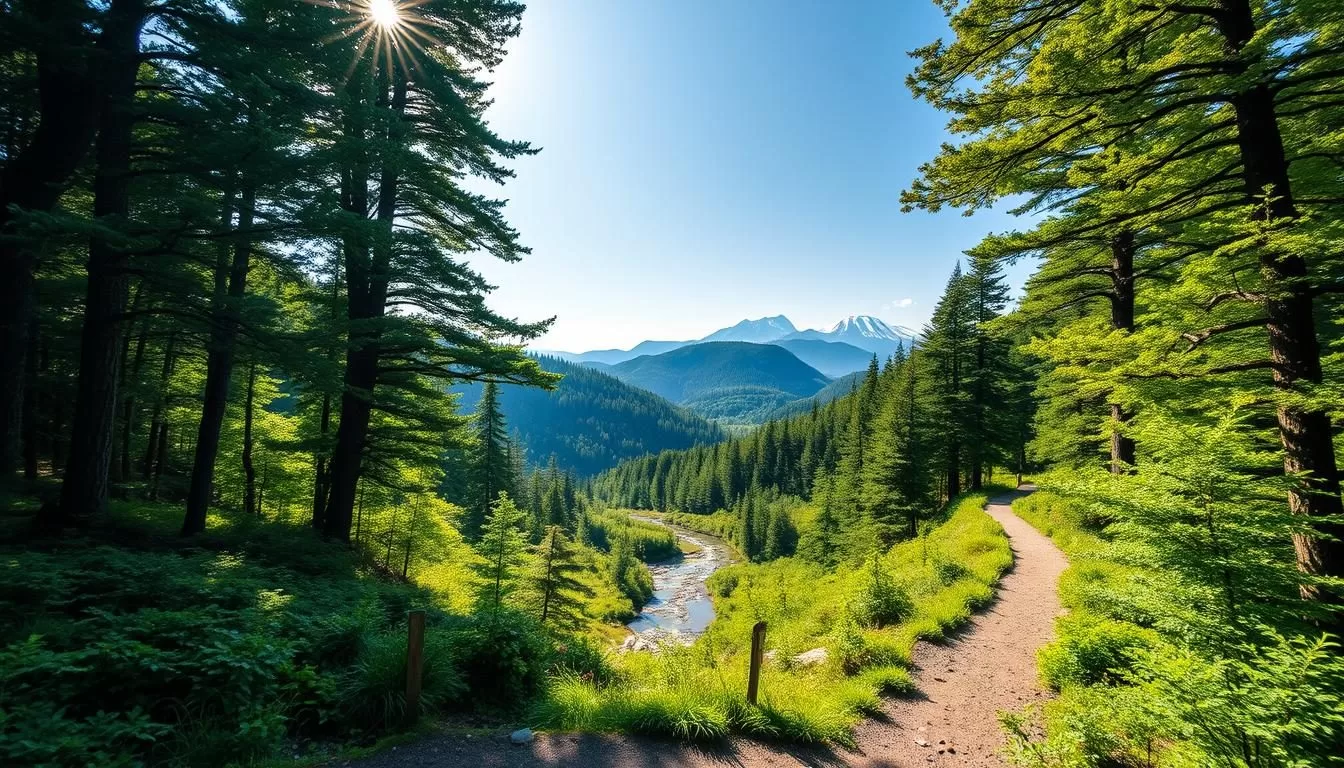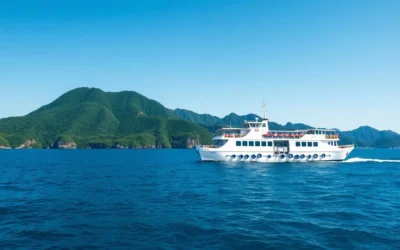✓ Accommodations ✓ Flights ✓ Rental Cars
Welcome to Daisetsuzan National Park, a true wilderness gem nestled in the heart of Hokkaido island, Japan’s last frontier. As the largest national park in the country, it offers an unparalleled hiking experience with its diverse landscapes, ranging from volcanic peaks to alpine meadows and crystal-clear lakes.
You’re about to embark on a journey through one of Japan’s premier hiking destinations. With trails for all levels, from leisurely nature walks to challenging multi-day treks, you’ll discover the park’s stunning natural features and rejuvenating hot springs. Whether you’re an avid hiker or a nature enthusiast, this guide will help you plan your visit, including the best time to go and transportation options.
As you explore Daisetsuzan’s vast wilderness, you’ll be immersed in breathtaking landscapes and unique wildlife. Get ready to experience the best of what this magnificent park has to offer.
Discovering Daisetsuzan National Park: Japan’s Wilderness Gem
Daisetsuzan National Park, Japan’s largest national park, offers an unspoiled wilderness experience like no other. Located in the heart of Hokkaido, it is a haven for those seeking adventure and a deep connection with nature.
The Natural Landscape of Daisetsuzan

The natural landscape of Daisetsuzan is characterized by its rugged mountains, serene valleys, and picturesque lakes. The park’s diverse scenery changes dramatically with the seasons, offering a unique experience throughout the year.
In summer, the park is adorned with vibrant alpine flowers, creating a colorful paradise for nature enthusiasts and photographers.
Wildlife and Vegetation
Daisetsuzan National Park is home to a rich diversity of wildlife, including the Hokkaido brown bear, deer, foxes, and numerous bird species. Visitors can enjoy spotting these creatures while maintaining a safe distance.
- Daisetsuzan National Park is home to a rich diversity of wildlife, including the Hokkaido brown bear, deer, foxes, and numerous bird species.
- During summer months, the park transforms into a colorful paradise with alpine wildflowers carpeting the meadows, creating spectacular scenery for nature photographers.
- The park’s vegetation changes dramatically with the seasons, from lush greenery in summer to vibrant autumn colors in September and early October.
- You’ll find unique alpine plant species that have adapted to the harsh mountain environment, many of which are endemic to Hokkaido.
- Wildlife viewing opportunities are abundant, though visitors should always maintain a safe distance, especially from bears, and follow proper wildlife observation etiquette.
Planning Your Visit to Daisetsuzan National Park
As you prepare for your adventure, planning your visit to Daisetsuzan National Park is crucial for a memorable experience. Located in the heart of Hokkaido, this vast wilderness area offers numerous hiking trails, scenic landscapes, and relaxing onsen towns.
Best Time to Visit

The best time to visit Daisetsuzan National Park depends on your preferences. Summer is peak season, with warm weather and long days ideal for hiking. However, it’s also the busiest time. If you prefer fewer crowds, consider visiting during the shoulder season (spring or autumn), when the scenery is equally breathtaking.
How to Get There
Daisetsuzan National Park is accessible by car or public transportation. The nearest major city is Asahikawa, which has an airport and train station with connections to Sapporo and other parts of Hokkaido. From Asahikawa, you can take a bus or drive to the park’s entrance.
Park Entrance and Fees
Unlike many national parks worldwide, entrance to Daisetsuzan National Park is free, making it an accessible option for budget travelers. However, you’ll need to budget for the ropeway services if you plan to access the higher elevation trails. The Asahidake Ropeway costs approximately ¥3,200 (about $22 USD) for a round trip, while the Sounkyo-Kurodake Ropeway costs around ¥2,400 (about $16 USD) for a round trip.
- Entrance to Daisetsuzan National Park is free.
- The Asahidake Ropeway and Sounkyo-Kurodake Ropeway provide convenient access to higher elevation trails.
- Plan your hiking schedule according to the ropeway operating hours (typically 6:00 AM to 6:00 PM in summer).
Top Hiking Trails in Daisetsuzan National Park, Japan: Best Things to Do – Top Picks
Daisetsuzan National Park is a hiker’s paradise, featuring trails that range from easy scenic hikes to challenging day-long adventures. With its diverse landscapes and breathtaking views, it’s a must-visit destination for outdoor enthusiasts.
Sugatami Pond Loop: An Easy Scenic Hike
The Sugatami Pond Loop is a serene and picturesque hike suitable for all skill levels. This easy loop offers stunning reflections of the surrounding mountains in the pond’s calm waters.

Nakadake Onsen Hike: Hot Springs and Volcanic Scenery
The Nakadake Onsen Hike is a unique experience that combines volcanic landscapes with the relaxing ambiance of hot springs. Hikers can enjoy the scenic views and rejuvenate at Nakadake Onsen.

Asahidake-Kurodake Traverse: A Day-Long Adventure
The Asahidake-Kurodake Traverse is an ambitious day hike that connects the eastern and western sections of the park. This 7-8 hour trek takes you from Asahidake Onsen to Sounkyo Onsen, offering diverse landscapes and panoramic vistas. To make the most of this hike, consider using a luggage transport service like Yamato (TA-Q-BIN) to send your belongings ahead.
You’ll experience some of the most remote and pristine views in the park, traversing high alpine terrain. While challenging, this hike provides a taste of the longer Daisetsuzan Grand Traverse without requiring multiple days of camping.

Exploring the Volcanic Wonders
As you explore Daisetsuzan, you’ll discover the awe-inspiring volcanic terrain that makes this park so unique. The park is home to numerous volcanic features, including Japan’s highest peak, Mount Asahidake, and various fumaroles that create a surreal landscape.
Mount Asahidake: Hokkaido’s Highest Peak

Mount Asahidake stands as Hokkaido’s highest peak, offering hikers a challenging yet rewarding experience. The trail to the summit is known for its steep incline and breathtaking views. As you hike, you’ll be surrounded by the unique scenery that characterizes Daisetsuzan National Park.
Fumaroles and Unique Volcanic Features
The fumaroles of Daisetsuzan create one of Japan’s most unique landscapes, where you can safely observe volcanic activity up close. Around Sugatami Pond, you’ll witness steam vents releasing clouds of vapor, creating a mystical atmosphere, especially during cooler mornings. The area is also known for its “poisonous onsen” in Ohachi-Daira Valley, colorful, mineral-rich hot springs that are too acidic for bathing but are spectacular for photography.
The distinctive sulfur smell and occasional rumbling sounds provide a sensory reminder that you’re walking on an active volcanic mountain. These volcanic features are easily accessible via the park’s trail network, with the most dramatic displays visible from the Sugatami Pond Loop and along the trails to Mount Asahidake, making for a memorable hikes daisetsuzan national experience.
Relaxing in Onsen Towns
The onsen towns surrounding Daisetsuzan National Park provide a serene escape, blending natural beauty with relaxation. After a day of exploring the park’s vast wilderness, you can unwind in the hot springs and enjoy the tranquil atmosphere.
You can take a direct bus to Asahidake Onsen or Sounkyo Onsen via Asahikawa City. Both towns offer a range of accommodation facilities, including camping grounds, hostels with outdoor onsen, and luxurious onsen hotels.
Asahidake Onsen: Gateway to the Eastern Park

Asahidake Onsen serves as a convenient base for exploring the eastern part of Daisetsuzan National Park. You can enjoy hot springs and relax in a peaceful mountain atmosphere. The town offers various accommodation options, from budget-friendly to luxurious.
Sounkyo Onsen: Western Base for Exploration

Sounkyo Onsen, located in a dramatic gorge on the western side of the park, offers more amenities than Asahidake Onsen while maintaining a peaceful atmosphere. It’s an excellent base for exploring the Kurodake area, with a ropeway providing access to high-altitude trails. You’ll find a wide range of accommodation options, including budget-friendly hostels and luxurious hot spring hotels. The transport service, TA-Q-BIN, allows you to forward your luggage between Asahidake Onsen and Sounkyo Onsen, making it easy to traverse the mountains.
Both onsen towns offer a unique experience, with Sounkyo Onsen being particularly renowned for its healing hot springs, perfect for relieving muscle fatigue and joint pain after a day of hiking.
Practical Tips for Visitors
Before you embark on your journey to Daisetsuzan National Park, consider these practical tips to make your trip enjoyable and stress-free.
Safety Considerations and Bear Awareness
When exploring Daisetsuzan National Park, be mindful of the wildlife, especially bears. Make noise while hiking to avoid surprising them, and keep a safe distance if you encounter any.
What to Pack for Your Adventure
Packing the right gear is crucial. Bring layers for changing weather, sturdy hiking boots, and essentials like food, water, and a map. Consider using a luggage transport service if you plan to hike between different locations.
Transportation Within the Park
Getting around Daisetsuzan National Park can be challenging due to limited bus services. You can use the ropeways at Asahidake and Sounkyo to access higher elevations. For a more flexible trip, consider renting a car, but be aware that parking can be limited during peak season. Alternatively, you can forward your luggage between onsen towns using services like TA-Q-BIN, allowing you to hike with just a day pack.

Conclusion: Making the Most of Your Daisetsuzan Experience
The grandeur of Daisetsuzan National Park leaves a lasting impression on all who visit. With diverse experiences for every type of nature lover, from casual day-trippers to serious backcountry hikers tackling the challenging Grand Traverse, the park offers something for everyone. To fully appreciate the park’s beauty, consider spending at least 2-3 days exploring different areas and trails, and don’t miss the opportunity to soak in the hot springs between adventures. Timing your visit to coincide with seasonal highlights can dramatically enhance your experience. Whether you’re drawn to the volcanic landscapes, peaceful forests, or wildlife viewing opportunities, Daisetsuzan National Park is one of Japan’s most rewarding natural treasures.
The above is subject to change.
Check back often to TRAVEL.COM for the latest travel tips and deals.






